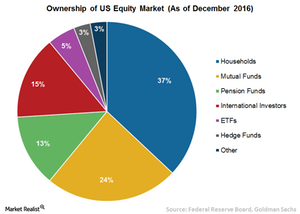Jury Hasn’t Decided on ETFs’ Role in Stock Market Rise
Although ETF (VTV) ownership increased substantially during the last 20 years, it still isn’t high enough to meaningfully impact stock prices.
June 12 2017, Updated 1:05 p.m. ET

TETF
Quantifying Ownership
The answers to this bubble question can be found in data. Although the growth of ETF assets remains high they only own about 6.29% of the market capitalization of your average US equity.
Some stocks will have higher ETF ownership, meaning ETFs are more likely to affect valuations of underlying stocks, and some are going to have lower-than-average ETF ownership, meaning ETFs are less likely to affect valuations.
Apple (AAPL), one of the most widely held stocks, to get a better handle on this bubble question. Apple is 4.7 percent owned by ETFs. It represents 2.5 percent of our investable universe and only 2 percent of ETFs assets. In other words, it’s slightly under owned by ETFs. It appears very difficult to argue that Apple’s share price is being influenced by ETFs and that ETFs owning popular stocks like Apple are creating a bubble.
In other words, what’s true about Apple is also true of just about all large-cap stocks in the S&P 500 Index. The data just does not support the argument that ETFs are what’s causing the market to reach all-time highs. But ETFs are a convenient access point, and that’s about it. Below we list the average equity market cap ownership by ETFs of major Indexes:
S&P 500 (SPY): 4.7%
Russell 1000 (IWM): 4.8%
S&P 1500 (ITOT): 4.9%
Market Realist
ETFs still own a small percentage of US stocks
Although ETF (VTV) ownership increased substantially during the last 20 years, it still isn’t high enough to meaningfully impact stock prices. While ETFs had 1% ownership of US stocks in 2000, their current holding is far less than other types of investment vehicles. According to data from the Federal Reserve Board and Goldman Sachs Global Investment Research, as of December 2016, ETFs had 5% ownership of US equity markets—compared to 24% for mutual funds, 13% for pension funds, 15% for international investors, and 3% for hedge funds. As a group, household investors continue to hold the largest chunk of US stocks with a 37% share.
No conclusive evidence
While ETFs’ popularity is certainly growing rapidly as investors become aware of their advantages compared to other investment options, the above data clearly show that ETFs are still a very small portion of US equity markets. Citigroup’s analysis of shareholder data pertaining to large US stocks revealed that out of the total shares available for sale, only 22% were held by passively managed funds. Similarly, for ex-US global markets, Citigroup found substantially lower stock ownership by passive funds. In conclusion, Citigroup couldn’t find any conclusive evidence that suggests a direct relationship between ETFs’ growth and their influence on share prices.
